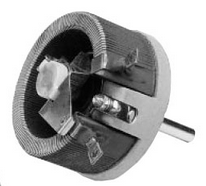We sometimes receive enquiries for potentiometers and rheostats that indicate there is some confusion between terminology surrounding potentiometers and rheostats. fundamentally there is little difference between the two. They both have the following characteristics:
- Allow for variable and continuous adjustment of a specified resistance value
- Allow for adjustment via a rotary shaft
- Are mounted (generally) via a bush mounting system
- Have similar temperature derating curves
- Both offer solder or quick connect termination options
- Both have a specified angle of rotation
- Both have a wiper in totational contact with a resistance element
As we can see from the photographs below, there are physical similarities between the two (potentiometers and rheostats):
So What Are The Differences Between A Potentiometer And A Rheostat?
The basis differences between a rheostat and a potentiometer are in the power ratings. In the Australian Resistors product range, the AW series potentiometer is rated at 3 watts. Compare this to the APR series rheostats which are available up to a 500 watt power rating – a huge difference.
So selection between a potentiometer and a rheostat comes to to the required power rating of the electrical application. low power applications generally call for a potentiometer whereas a high power application will best be served by use of a rheostat.


